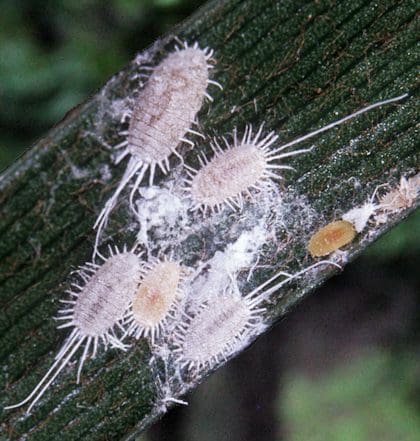Mealy Bugs

It’s not hard to recognize mealy bugs. They look like many-legged blobs that have been rolled in flour. You’ll see them creeping slowly along stems and the undersides of leaves, and find their eggs suspended in cottony sacks. Some also attack roots.
Mealy bugs feed by piercing plant surfaces with mouths that work like hypodermic needles. As they suck out sap, they also excrete a sticky substance which coats the foliage. Called “honeydew,” this excretion first looks like honey, but soon turns a moldy black. The sticky coating makes it difficult for the plant to breathe, and may also attract ants.
Symptoms:
Usually you can see the insects themselves, their eggs, and the honeydew. Like most pests, mealy bugs don’t like light, so look for them on the undersides of leaves and stems. Root-feeding mealy bugs cause plants to grow slowly and wilt between feedings. If you think a plant has them, remove some potting medium and you may see blobs at work just below the surface.
Life cycle:
Mealy bugs are on the move most of their lives, and since they live for six weeks to two months, just one can cover a lot of plant surfaces. Females mature, lay their eggs, then die. The eggs hatch in five to ten days, or wait longer until conditions are more to their liking. All this means that if just one mealy bug, or one egg sack, survives your treatment, the insects will continue to feed and breed.
Controls:
If the infestation appears to be very limited, dab each bug with a cotton swab that’s been dipped in rubbing alcohol, then rinse the leaves in lukewarm water. Another alternative is to wash the entire plant with a solution of two teaspoons of mild dish detergent to a gallon of water. Expect the mealy bugs to resist treatment – they’re protected by a waterproof wax – but the soap can break that down. Isolate the plant in case you’ve missed any bugs or eggs, and check again in a week or so. You’ll probably need to wash a second and maybe a third time as well. If a plant has just a few root-feeding mealy bugs, you may find it necessary to submerge the pot in soapy water for about 15 minutes, then rinse with clear water.
